Mischief’s Misadventure (in the Upper Peel inlet)
Part Eight of the Tale of Mollymawk's Expedition from Natales to EdenWhen Bill Tilman set off across the South Patagonian ice cap his ship was left in the command of one W. A. Procter. Tilman never refers to him by any other name, and so Procter he shall be to us also (although I happen to know that his name was Bill). Of Mischief‘s entire crew this man was the only one besides the owner who had done any offshore sailing before they set out for South America, and he had been invited to join the ship specifically on account of the need for a second captain.
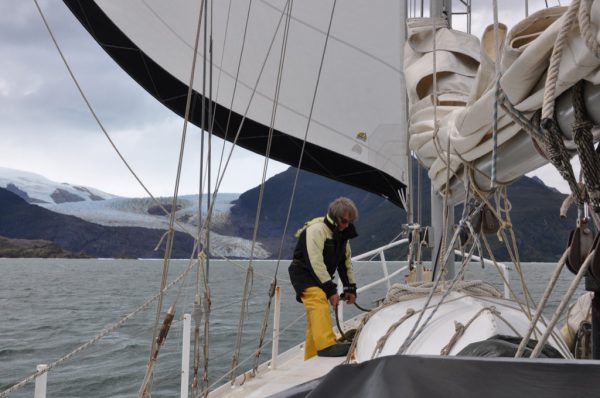
Tilman had it in mind that while he and his fellow mountaineers were crossing and re-crossing the ice-cap their boat would wait for them at Puerto Bueno; but having seen Puerto Bueno, Procter and his crew evidently had other ideas. They had often heard Tilman talk about the upper reaches of the Peel Inlet and they were aware that, so far as anyone knew, nobody had ever been up there. They also now had plenty of experience of manoeuvring in ice; and the boss didn’t seem to mind his boat being shunted through it. Nothing was said, for that might bring upon them a restriction – and besides, to spill the beans would spoil things – but… why should these other chaps have all the fun? While the climbers were winning their laurels as the first men to cross the ice-cap, why shouldn’t the stay-behinds achieve their own ‘first’ and have their own moment of glory?
That, I imagine, is how the thinking went. How long she remained in the Calvo inlet after Tilman and his oppos set off up the glacier we are not told, but eventually Mischief headed back out into the bay, and rather than turning left and going back down the Peel inlet towards Puerto Bueno she turned right.
So, too, did Mollymawk after our visit to the Calvo glaciers.
Besides offering the opportunity to visit another half a dozen glaciers, the upper Peel Inlet has a further distinction: When you’re at the head you’re only 4½ miles from the border with Argentina and only ten miles from a lake which communicates with the Atlantic – which is quite something to think about!
Even nearer to the border than Lago Argentino is another, very much smaller lake, and the only thing keeping the two from being one is a glacier. Thus, when the glaciers melt Lago Argentino will extend to within little more than four miles from the upper reaches of the Peel.
Yes, Patagonia is very nearly an island!
Tilman and his companions spent six weeks crossing and re-crossing the ice-cap, the greater part of this time being spent in finding a way up the glacier from the Calvo inlet. Charles Marriot, suffering from frost-bitten feet, didn’t quite make it down to Lago Argentina – he waited while the others made the final descent – and thus Tilman and Jorge Quinteros became the first men to complete the journey. (Various previous expeditions had failed, largely on account of bad weather.) A full account of the expedition is given in Mischief in Patagonia.
Communication with the yacht being impossible during the climbers’ absence, an arrangement had been made whereby Mischief would return to the Calvo every Sunday to see whether they were back. Since the day of their return was a Friday, Tilman was pleased to note that they would not have too long to wait. However, on regaining the beach his mood of jollity dissolved. Two notes had been left for him, one containing good news and the other bad.
The good news was that the Chilean navy, having agreed to bring a delivery of petrol and paraffin to Puerto Bueno, and having discovered that Mischief was not at that place, had come looking for her and had found her. Tilman offers thanks to the captain of the vessel which made this drop and in so doing he solves a riddle: The bay from which the Calvo and the Upper Peel branch is called Bahia Chubretovitch – and Chubretovitch was commander of this vessel. Presumably, while he was up here delivering Tilman’s groceries he surveyed the bay and thereby made his mark for posterity.
The bad news was that during Tilman’s absence Mischief had been aground and had damaged her propeller. She was now without an engine. That probably sounded dire, but as her owner soon came to realise, she had actually got off very lightly. The fact is that the boat was very nearly lost; and if she had been lost then her crew, and the mountaineers too, would have been in very desperate straits, for this is not a part of the world where the shipwrecked mariner can live off the land.
It happened thus:
On the northern side of the Bahia Chubretovitch the Peel Inlet narrows and begins to wind its way into the mountains. Eventually the traveller comes to a narrow pass, his way partly blocked on the southern side by an islet and on the northern side by the wash-out from a glacier. Into this narrow pass Mischief went – at five knots with the wind on the stern. To be travelling thus in uncharted waters is foolish, to say the least, and comeuppance was not long in coming up.
The boat touched. Then, in the next instant, with her way helping her along, she bounced over the hidden moraine and continued up the estero.
“Judging it wiser to go no further without investigating, particularly as we could now see …. large ice-floes, apparently aground, in the narrowing waterway, we anchored in six fathoms in mid-stream.”
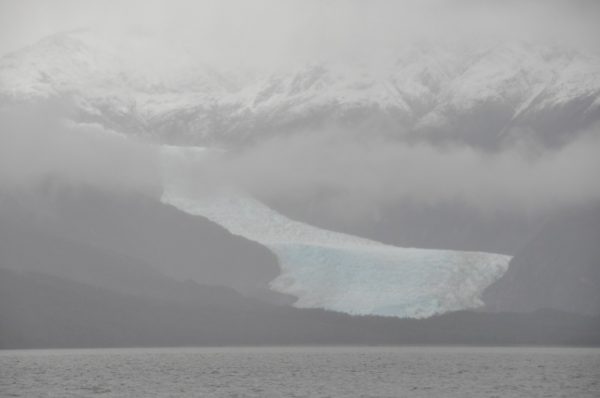
Procter and Mike Grove (the author of the account) then rowed off to look for a better haven for the night. The sound of sealions roaring drew them to a cove about half a mile away. Having decided that this Sealion Bay would suit their purpose they returned to the boat. By now the ice-floes were being swept down towards her. Without having made any soundings, Procter weighed anchor and headed for the cove; and within minutes they were aground.
This time there was no getting off, partly because the boat didn’t have enough way on her but also because the tide was falling. In the failing light they could make out the boulder-strewn bottom, but such useful observations came too late.
Having so incompetently got the boat into this mess, Procter and his crew now demonstrated a far greater intelligence and a great deal of energy and resourcefulness in getting her out of it again. Having failed to pull her off with kedges they saw that their only hope was to lighten her load, and so they set about moving every piece of ballast ashore to a nearby islet. This business was only possible at slack water as the heavily laden dinghy could not be rowed against the strong current. It’s worth noting too that before they could get those heavy iron pigs ashore they had to haul them up out of the bilge; and before they could do that they had to take the boat’s furniture apart. It’s also worth noting that whereas loose ballast is generally not something to be recommended, a boat with a solid lead keel (such as Mollymawk) could not be lightened in this way.
The men spent two days rowing the pigs ashore, working day and night whenever the tide allowed them; and all the while the current rushed, now up and now down the inlet; and all the while the ice-floes assaulted Mischief. Procter had rigged the topmast as a leg to stop the boat falling over at low tide (when she was almost high and dry), and the men had also cut some small trees to use as props, but the ice repeatedly knocked these supports away. Inspecting the hull from the dinghy, Mike Grove observed that the planks were badly scraped, the rudder was chipped, and there was one blade missing from the propeller.
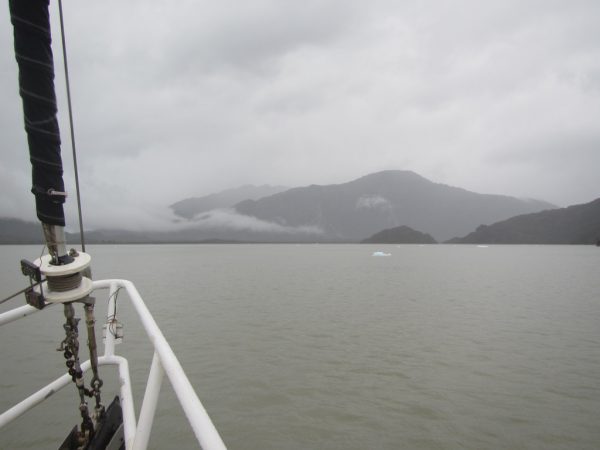
That same evening, as Procter was rowing ashore to Ballast Bay with yet another load of pigs, the boat suddenly lifted off and began drifting upstream. Grove hastily threw out the anchor.
The night was spent fending big boulders of ice away from the yacht. By now the men had had the sense to sound a passage through the moraine and, with the wisdom which comes from hindsight, they wanted to wait until the tide was rising before they got underway – but it sounds as if there were times during that night when they wondered if they would survive. While the boat was on the reef she had been inaccessible to the bigger bergs, but now they came sweeping down on her.
Eventually the hour arrived and, tired out from the battle, the crew weighed anchor and started the engine. Cautiously they made their way through the moraine; and then they retreated to Sealion Bay and they slept.
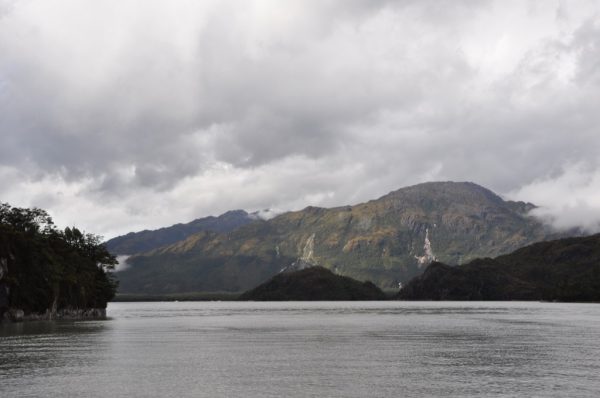
This is not quite the end of the story, because on the following day the men had to go back to that islet and fetch their ballast; and while they were so engaged the engine developed a horrendous knocking sound and water began pouring into the boat via the shaft.
With the engine off, the water stopped – but the boat began drifting back towards the moraine! Mercifully, at this moment a breeze arose – a headwind, but a wind nonetheless. So they hardened the sheets and spent the next little while nervously tacking to and fro, desperately trying to buck the current. And they made it back into Sealion Bay.
On the morrow they sailed back down to Mischief Cove (as they had named it), on the north side of the Calvo inlet; and then, deciding that they preferred to be somewhere more relaxing, they relocated to an anchorage some four miles without the bay.
A glance at the chart showed us where Procter’s Bay must be, and as the day drew to a close, having no desire to once again try our luck in the entrance to Caleta Capitan Constantino, we went to check it out. The place is open to the west – and as the wind was now blowing from the west this made it a leeshore – but Mischief evidently spent several weeks here without coming to grief, and so we decided that it would probably do us for a night. Certainly, we’ve anchored in far worse places. (To be specific, Bahia Procter seems to us to be safer than either Puerto Natales or Puerto Consuelo.)
Bahia Procter is just downstream from the Matthew glacier and around a low headland. The best anchorage seemed to us to be immediately west of the mouth of a shallow river. We think it would probably be quite easy to walk along the river to the glacier, but since the following day was thoroughly nasty, with very heavy rain, we didn’t put this theory to the test.
Notwithstanding Procter’s tale of misadventure, we now planned to sail up to the top of the Peel Inlet. I’ve no idea what yacht it was which first discovered that there is, in fact, a way through Mischief’s moraine, but that way is now recorded in the cruising guides; so we were not heading into wholly uncharted waters.
On the other hand, the guides show very few safe havens in this inlet so we also wanted to see if we could add to the store of knowledge. To this end we crept along the shore, nosing our way into every likely indentation (and almost running onto a lonely rock at one stage). Various half-suitable places were identified and one reasonably good one, and they were named accordingly – Caleta Vague-Possibility; Caleta Maybe; Caleta Snug; Caleta Mayor; Caleta North-Only; Caleta Opposite.
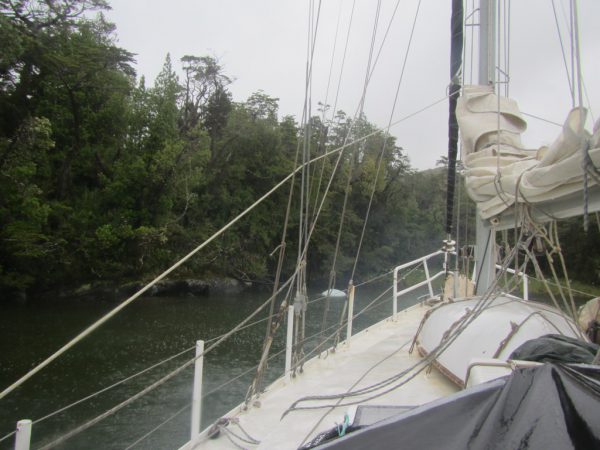
Eventually we arrived at Sealion Bay. A neat U-shaped cove set into the north side of a small headland, this place is so vastly superior to a berth on the reef that it must have seemed to Procter and Co. to be absolute heaven. Besides, previous to their adventures on the reef they had been anchored off a glacier in amongst the ice. By comparison to Caleta Mischief, Sealion Bay is a first class haven, its only drawback being that it is open to the prevailing wind.
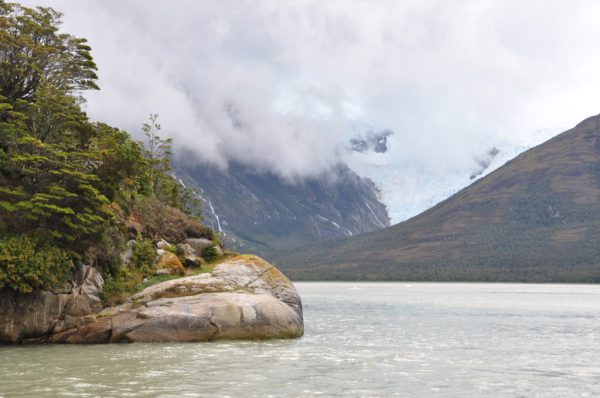
On our arrival we tucked in under the low cliffs on the west side of the bay, the better to avoid the wind bowling down the inlet – but the gusts still reached us. Provided the wind didn’t get up then all would be well, but the forecast showed the possibility of a force five.
And then it dawned on us. The obvious thing to do was to look for a cove on the opposite shore, either on the lee side of Isla Tilman – (yes, the cartographers have named it for Tilman himself, even though he wasn’t aboard!) – or else in the lee of the adjacent headland.
We motored over to have a look; and we found a perfectly little nook under the headland. The water being deep right up to the shore we had to drop the anchor a little nearer in than we would have liked and in 16m… but there was no problem finding somewhere to tie stern lines on the little beach just aft of us, and just to be on the safe side we also set bow lines.
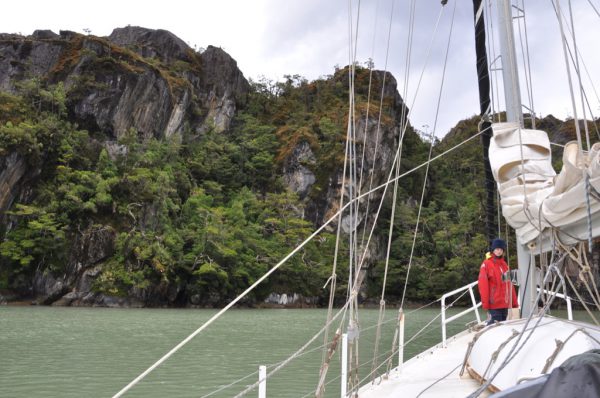
And there we had it – voila! A nice little lodging, with an impressive rock hanging almost over the aft deck. Just so long as it didn’t chose this particular night to come tumbling down all would be well…
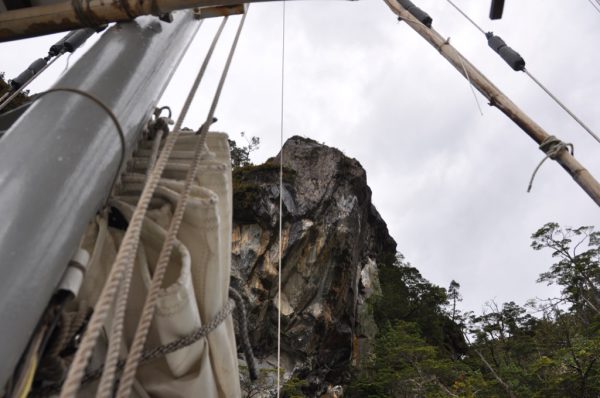
Hummingbirds zipped to and fro in the rain, feeding from the bright red flowers on the bushes and now and then checking out the new tree which had appeared on the edge of their forest. They gave the place a friendly feel. We paid them much more mind than we did the vultures which hovered nearby. All in all, we were feeling rather pleased with ourselves and weren’t in the mood to notice ill omens.
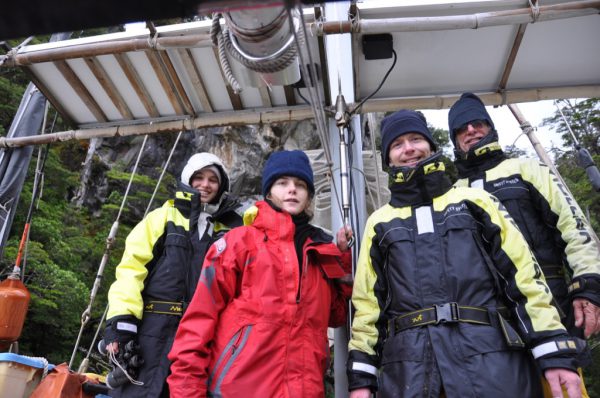
Half an hour later, just as dusk was falling, our quiet little nook was hit by a south-westerly squall.
A south-westerly! In the upper reaches of this high-walled corridor!
It can only have been a local effect, but the question was, would it last?
Within two minutes, while we dithered, the wind reached force six and the sea around us began to roll. The boat began to pitch up and down. We were so close to the shore that if the anchor budged or the bow-lines parted we wouldn’t stand a chance of keeping her off the rocks. We had to get out. Fast!
Caesar and Tania leapt into the dinghy. I was for dropping the shore lines and fetching them on the following day, but there was no time to argue about it. How suddenly this millpond had become a dangerous sea! Half an hour before, it had been almost like a mirror; now, Tania struggled to get ashore. Once she was on the beach the stern lines were easily reached, and as soon as they were loose I began hauling them in.
The starboard bow line was tied to a tree which leant over the water. Getting it up there had taken some doing, but Caesar had eventually managed to throw it over the trunk. Since he had given the knot a big long bight it was easily released. The port bow line was another matter. It had been taken to the top of a nearby rock, and getting onto the rock while the waves rolled by proved impossible.
“Leave it!” we shouted; and Nick cast off the line. He was already winding in the anchor while I stood over the wheel, now and then easing the boat forward with blasts from the engine.
And thus we escaped from Caleta Trap! and, in the gathering dusk, made our way back to Sealion Bay.
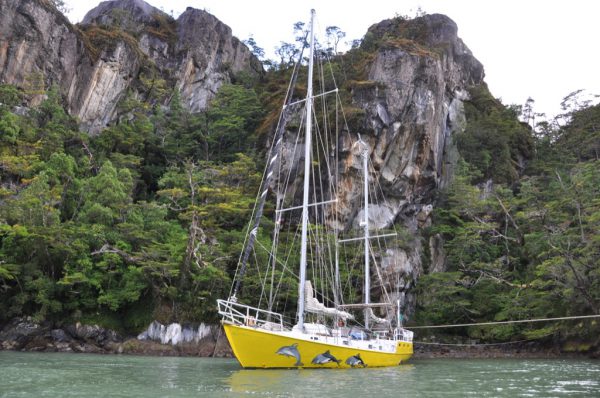
Undaunted still, we had every intention of proceeding with our plan on the following day, and going through the Mischief Narrows and into the head of the inlet. However, the weather had other ideas. The forecast promised heavy rain for the following five days. A glacier in the rain is hardly worth seeing – in fact, you can’t really see it – and so, unwilling to pass such a long time in such an unsatisfactory harbour we decided to retreat.
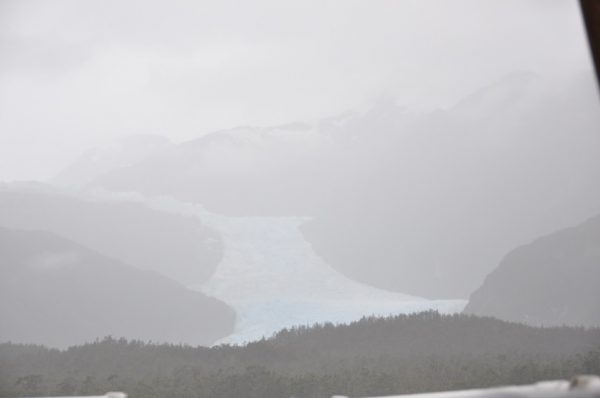
We fetched our shoreline from Caleta Trap! and then we began the journey back down the fiord. As we bowled along the Peales dolphins came to join us, and they rode with us for more than an hour. At times they seemed to be actually touching the boat, and every now and then one of them would turn on its side and gaze up at us gazing down.
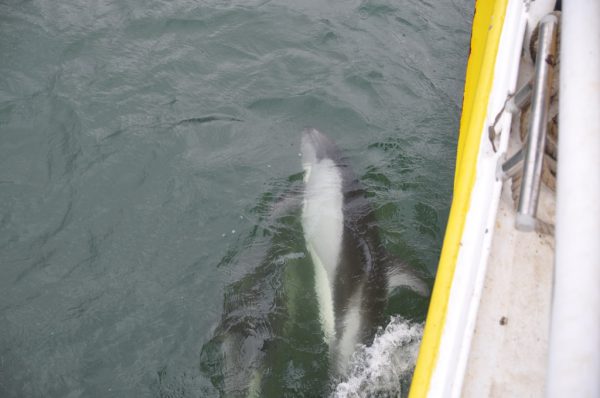
At the end of the day we pulled over into Caleta Villarrica, which is a ‘secret’ lagoon hidden within a narrow portal. Aside from Caleta Amalia, it’s about the only really good, safe, readily-accessible anchorage in the whole of the Peel Inlet. As we dropped the anchor and made ready to take our stern lines ashore two otters swam away from the beach.
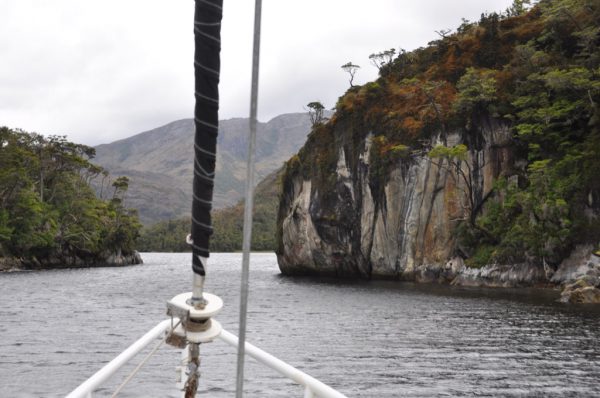
Heedless of the rain, which had been falling without cease all day, we walked – or rather, wrestled our way through the trees – to a lake; and here the more courageous of the crew also swam. Or at any rate, they stripped off and got themselves wet.
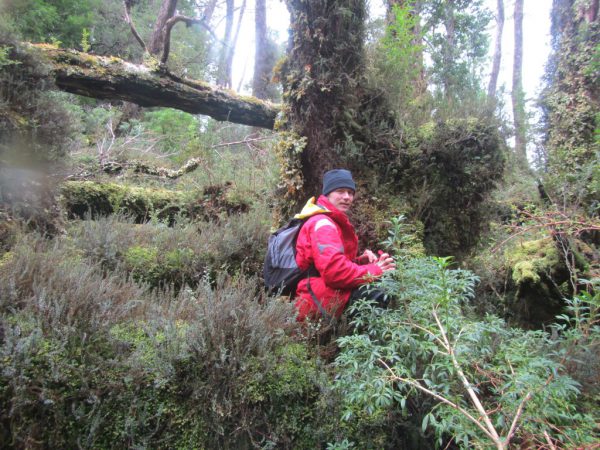
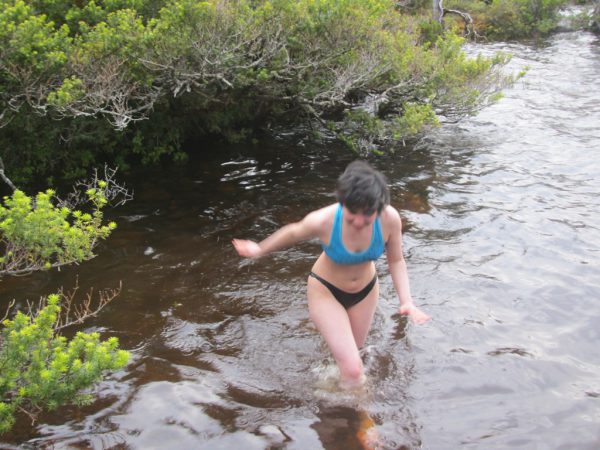
In honour of the first to take the plunge, I give you Lago Tania. May future generations enjoy wondering who she was who left her name, so, upon the chart.

Dear author, a few comments:
Early 1956.
1. Mischief ceased to communicate position every 24 hours to the MRCC in Punta Arenas. This triggered alarms and the patrol ship Lautaro that luckily was sailing south to Punta Arenas not far from the southern ice field was directed to search for Mischief on a SAR mission. First thing was to check Puerto Bueno where fuel had been stored for Mischief. The fuel was still there.
2. Due to good luck and professionalism, after sailing many nautical miles in completely uncharted waters, the Lautaro found the stranded cutter in the far end of estero Calvo. Tilman was not onboard. The ship had no fuel, was very low on food, had dead batteries (hence no radio communications), the engine was faulty and the propeller was damaged.
3. The crew of the Lautaro not only found Mischief, but also repaired her engine and propeller, provided food and fuel and left the cutter in a ready for sail condition.
4. On Mischief, Lt Grove handed the captain a letter addressed to a lady in the UK. He said it was very important.
London, 1957
1 Tilman only met and thanked the captain the year after the incident, at the Annual Meeting of the Royal Geographical Society RGS in London, where he lectured the audience about his experience in the southern ice fields.
2 The captain of the Lautaro was also congratulated and thanked by HRH Prince Philip, Duke of Edinburgh, patron of the RGS.
3. When the captain of the Lautaro and Lt Grove met again in that meeting, Grove introduced the captain his fianceé. The letter that he had put in the mail in Punta Arenas contained the proposal.
Chile, 1958
The captain of the Lautaro received a dedicated and signed copy of Tilman’s new book “Mischief in Patagonia”, again thanking him.
Chile, around 1995
The Chilean Hydrographic Office published a new nautical chart of the area. This one had dense and comprehensive soundings. Following their standard procedures, they investigated historical reports and decided to name Mischief the narrows and Chubretovich the big bay that leads to the narrows.
Chile, 2014
I named my Nauticat 39 sailing yacht “Mischief”, in honour of Tilman and the captain of the Lautaro.
Additional comments:
1. The captain of the Lautaro was Lt Cdr, later admiral, Carlos Chubretovich, my father.
2. Apart from many incorrect statements, your comment about the captain of the Lautaro “…making his mark for posterity” is rude and shows boldness which I presume is based on ignorance. I forgive you.
Best regards
Jorge Chubretovich
Rear admiral (Retd)
Chile
It’s nice to hear from you again, Jorge.
Thank-you for your interesting comments, which throw additional light on events. One small ‘correction’, if I may: Mischief was not equipped with a radio so cannot have been making daily reports. Indeed, even in these modern times a yacht which only has a radio cannot check in daily, because the range of the VHF radio is not sufficient. In the old days, before they had radios, yachtsmen on the ocean sometimes used to report their position to passing ships, and this is still the only way for many yachts to keep in touch while they are in the Channels. According to Tilman, the navy came looking for Mischief because she didn’t keep her appointment at Puerto Bueno.
I’m puzzled as to why you think that the comment about “making his mark for posterity” is rude. Making one’s mark is normally considered to be a positive thing!
Wishing you all the best,
Jill